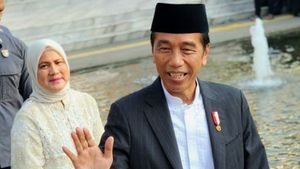Dut is the music of my country. That's the title of the song that was popularized by the vocal group Project Pop in 2003. Dangdut music is closely related to Indonesian people. Almost all groups like this music genre. Starting from old and young, people in villages to cities also like to listen to dangdut music.
And, good news has now come for dangdut lovers in the country. Dangdut was officially designated as the Intangible Cultural Heritage (WBTb). The determination trial was held by the Ministry of Education, Culture, Research and Technology on Monday, August 28 at the Millennium Hotel Tanah Abang, Central Jakarta.
The inauguration of dangdut as WBTb after an evaluation and improvement of the file from the application submitted by the Central Executive Board of the Indonesian Malay Music Artists Association (DPP-PAMM) on August 4, 2021, through the DKI Jakarta Culture Service and supported by the Betawi Cultural Institute (LKB).
The determination of dangdut as WBTb is not only to secure it so that it is not recognized by other countries, but is also expected to be able to become a fence for the nation's culture. In addition, this determination is also one way to register dangdut into a cultural heritage of UNESCO (United Nations Educational Scientific and Cultural Organization).
The term cultural heritage' has changed a lot in recent decades, partly due to instruments developed by UNESCO. Cultural heritage does not only stop at monuments and collections of objects. The importance of the intangible cultural heritage is not solely on the embodiment of the culture itself, but on the wealth of knowledge and skills inherited through this legacy from one generation to the next.
Quoted from the kemendikbud.go.id website, Takbentual Cultural Heritage or intangible cultural heritage is uncontrollable (intangible/abstract), such as concepts and technology; and its nature can pass and disappear in time as the times evolve, such as language, music, dance, ceremonies, and various other cultured behaviors.
Meanwhile, according to the 2003 UNESCO Convention Article 2 paragraph 2, the cultural heritage of the intangible is a variety of practices, representations, expressions, knowledge, skills - as well as instruments, objects, artifacts and cultural spaces related to it.
In some cases, society, group, or a person can also be part of an intangible cultural heritage. Simply put, the intangible cultural heritage is a cultural heritage that not all of them can be felt, but is known and felt.
After officially becoming a national unobtent cultural heritage, dangdut music will now be registered with UNESCO. This was revealed by the senior dangdut musician, Rhoma Irama.
"We have registered it with UNESCO as an intangible cultural heritage, driven by the government through the Ministry of Education and Culture," said the man who was nicknamed the King of Dangdut.
Prior to dangdut, Indonesia also proposed Reog Ponorogo to get recognition as an intangible cultural heritage from UNESCO. The UNESCO trial against Reog Ponorogo as WBTb is expected to take place in December 2024.
Indonesia has actually proposed dangdut as an unobtent cultural heritage since 2022. However, it can only be done after officially becoming a national WBTb. By submitting dangdut as an intangible cultural heritage to UNESCO, to avoid claims from other countries. Minister of Tourism and Creative Economy, Sandiaga Uno said dangdut is an Indonesian cultural identity.
"Dagdut music is the pride of the nation and cultural identity. We want to immediately propose that this is recorded and so that this will not be claimed by other countries," said Sandiaga Uno last year.
Launching kunesco.org, there are at least four conditions to be included in the category of intangible cultural heritage. First, WBTb does not only represent traditions inherited from the past, but also contemporary practices in rural and urban areas that involve various cultural groups.
WBTb must also be inclusive and representative. And lastly, the intangible cultural heritage can only become a legacy if recognized by the community, group, or group of individuals who create, maintain and spread it. Without recognition from them, no one else can decide that a certain expression or practice is cultural heritage.
Since 2008 until now, UNESCO has recognized 12 cultural heritages of non-objects and objects from Indonesia. Wayang became the first art recognized as WBTb by UNESCO in 2008, followed by Keris (2008), batik (2009), education and batik training in Pekalongan (2009), angklung (2010), dance Saman (2011), noken (2012), three traditional Balinese dance genres (2015), phinisi ship (2017), pencak silat (2019), pantun (2019), and finally gamelan (2021).
The existence of dangdut music seems timeless. Dangdut music is claimed to be rooted in Malay music, and according to the Encyclopaedia Britannica, dangdut music emerged in the 20th century.
While launching the Padang Institute of Technology, dangdut music was born from the influence of Indian music in the film Bollywood entitled 'Indian Boneka'. Apart from being influenced by Indian music, dangdut music is also influenced by Arabic music, especially in the clove parts and harmonization of the tone.
At the beginning of its appearance, the average dangdut song had the theme of romance. But over time, dangdut music also discusses various social issues, even as a medium for the da'wah of Islam.
This genre of music then continued to grow to ASEAN, even in the 1990s the popularity of dangdut music reached the countries of Turkey, Japan, Australia, and America. That year a Japanese businessman released about 200 songs belonging to Rhoma Irama which were then circulated in his country.
Dangdut's popularity is able to survive in today's era, amid the onslaught of a new, more modern genre of music. In the past few years, there has been a dangdut koplo that had reaped pros and cons. The erotic shaking that emerged from the dangdut koplo is considered to have polluted the dangdut that had developed in the previous era.
As is known, dangdut music was previously used as a da'wah medium that carries moral values, while the dangdut koplo is considered too erotic. The word koplo in the phrase dangdut koplo comes from Javanese which means stupid or stupid.
However, a quote from Weintraub, in a scientific work entitled The Sound and Spectacle of Dangdut Koplo: Genre and Counter-Genre in East Java, Indonesia, supports that the dangdut koplo is no different from the original dangdut.
After all, koplo is not a separate genre from dangdut (it has merged with other genres such as rock, pop, and local Javanese songs). Dangdut koplo is characterized through a special tabulation pattern, fast tempo, mixing of gender arrangements, and performances that tend to look erotic.
The English, Chinese, Japanese, Arabic, and French versions are automatically generated by the AI. So there may still be inaccuracies in translating, please always see Indonesian as our main language. (system supported by DigitalSiber.id)









